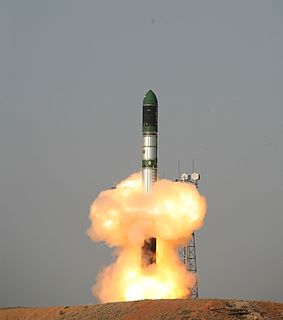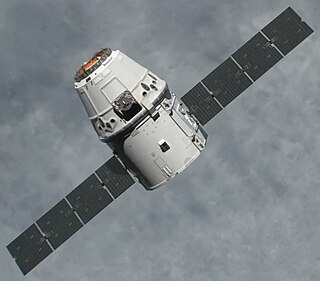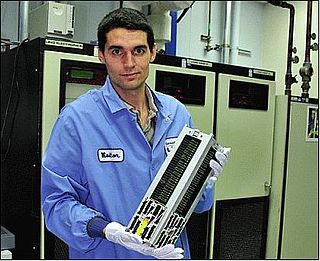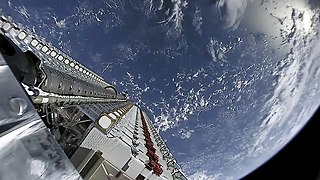Related Research Articles

In the context of spaceflight, a satellite is an object that has been intentionally placed into orbit. These objects are called artificial satellites to distinguish them from natural satellites such as Earth's Moon.
UoSAT-2, which is also known as UO-11 and OSCAR-11, is a British satellite orbiting in Low Earth Orbit. The satellite functions as an amateur radio transmitter and was built at the University of Surrey. It launched into orbit in March 1984 and remains orbital and active, though unstable with irregular periods of transmission. All of the Analog telemetry channels have failed, making telemetry from OSCAR 11 useless. The satellite was still heard transmitting telemetry in 2015, thirty years after launch.

A small satellite, miniaturized satellite, or smallsat is a satellite of low mass and size, usually under 500 kg (1,100 lb). While all such satellites can be referred to as "small", different classifications are used to categorize them based on mass. Satellites can be built small to reduce the large economic cost of launch vehicles and the costs associated with construction. Miniature satellites, especially in large numbers, may be more useful than fewer, larger ones for some purposes – for example, gathering of scientific data and radio relay. Technical challenges in the construction of small satellites may include the lack of sufficient power storage or of room for a propulsion system.

The Dnepr rocket was a space launch vehicle named after the Dnieper River. It was a converted ICBM used for launching artificial satellites into orbit, operated by launch service provider ISC Kosmotras. The first launch, on April 21, 1999, successfully placed UoSAT-12, a 350 kg demonstration mini-satellite, into a 650 km circular Low Earth orbit.

Surrey Satellite Technology Ltd, or SSTL, is a company involved in the manufacture and operation of small satellites. A spin-off company of the University of Surrey, it is presently wholly owned by Airbus Defence and Space.
The Disaster Monitoring Constellation for International Imaging (DMCii) or just Disaster Monitoring Constellation (DMC) consists of a number of remote sensing satellites constructed by Surrey Satellite Technology Ltd (SSTL) and operated for the Algerian, Nigerian, Turkish, British and Chinese governments by DMC International Imaging. The DMC provides emergency Earth imaging for disaster relief under the International Charter for Space and Major Disasters, which the DMC formally joined in November 2005. Other DMC Earth imagery is used for a variety of civil applications by a variety of governments. Spare available imaging capacity is sold under contract.
UoSAT-12 is a British satellite in Low Earth Orbit. It is the twelfth satellite in the University of Surrey series and was designed and built by Surrey Satellite Technology Ltd. (SSTL). It was launched into orbit in April 1999 on board a Dnepr rocket from Yasny Russia.
TiungSAT-1 is the first Malaysian microsatellite. The satellite is developed through the technology transfer and training programme between Astronautic Technology Sdn Bhd (ATSB) Malaysia and Surrey Satellite Technology Ltd., United Kingdom. TiungSAT-1 was launched aboard Dnepr rocket from Baikonur Cosmodrome, Kazakhstan on 26 September 2000.
UoSAT-1, also known as UoSAT-OSCAR 9 (UO-9), was a British amateur radio satellite which orbited Earth. It was built at the University of Surrey and launched into low Earth orbit on 6 October 1981. It exceeded its anticipated two-year orbital lifespan by six years, having received signals on 13 October 1989, before re-entering the atmosphere.

The year 2011 saw a number of significant events in spaceflight, including the retirement of NASA's Space Shuttle after its final flight in July 2011, and the launch of China's first space station module, Tiangong-1, in September. A total of 84 orbital launches were conducted over the course of the year, of which 78 were successful. Russia, China and the United States conducted the majority of the year's orbital launches, with 35, 19 and 18 launches respectively; 2011 marked the first year that China conducted more successful launches than the United States. Seven crewed missions were launched into orbit during 2011, carrying a total of 28 astronauts to the International Space Station. Additionally, the Zenit-3F and Long March 2F/G carrier rockets made their maiden flights in 2011, while the Delta II Heavy made its last.

The year 2012 saw a number of significant events in spaceflight. In May and October, the first Commercial Orbital Transportation Services resupply missions took place, during which the SpaceX Dragon became the first private spacecraft to dock with the International Space Station (ISS). In June, China launched the crewed Shenzhou 9 orbital mission, and North Korea achieved its first successful orbital launch in December. 2012 also saw China's first successful asteroid exploration mission, and the landing of NASA's Curiosity rover on Mars. The Vega and Unha-3 rockets made their maiden flights in 2012, while the Proton-K made its last.

KickSat was a small-satellite (femtosatellite) project inaugurated in early October 2011, to launch many very small satellites from a 3U CubeSat. The satellites have been characterized as being the size of a large postage stamp. and also as "cracker size". The mission launch was originally scheduled for late 2013 and was launched April 18, 2014.
UoSAT-3, also known as UO-14 and OSCAR-14, is a British satellite in Low Earth Orbit. It was built by a spin-off company of the University of Surrey, Surrey Satellite Technology (SSTL) and launched in January 1990 from French Guiana. The satellite functioned as one of a series of OSCAR satellite in orbit around the Earth, as well as observing Earth and performing scientific experiments.
UoSAT-5, also known as UoSAT-F, UO-22 and OSCAR 22, is a British satellite in Low Earth Orbit. It was built by Surrey Satellite Technology and launched into space in July 1991 from French Guiana.
The Soviet–Canadian 1988 Polar Bridge Expedition began on March 3, 1988, when a group of thirteen Russian and Canadian skiers set out from Siberia, in an attempt to ski to Canada over the North Pole. The nine Russians and four Canadians reached the pole on 25 April and concluded their trek on Wednesday, June 1, 1988, when they reached Ward Hunt Island, Ellesmere, Northern Canada. At the North Pole, they were welcomed by a group of dignitaries from the Soviet Union and Canada, members of the international press, and radio amateurs involved in support and communications. The daily progress of the skiers was followed by many thousands of school children and radio amateurs around the world. They listened to the voice synthesizer on board the UoSAT-OSCAR-11 satellite, which transmitted the latest known position of the expedition in FM on the two-meter VHF amateur radio band, using digitised voice; and to progress reports, produced regularly by AMSAT-NA, which were distributed worldwide through amateur packet radio and orbiting amateur radio satellites.

Planet Labs, Inc. is an American private Earth imaging company based in San Francisco, California. Their goal is to image the entirety of the Earth daily to monitor changes and pinpoint trends.

Starlink is a satellite internet constellation being constructed by SpaceX providing satellite Internet access. The constellation will consist of thousands of mass-produced small satellites in low Earth orbit (LEO), working in combination with ground transceivers. SpaceX plans to sell some of the satellites for military, scientific, or exploratory purposes. The SpaceX satellite development facility in Redmond, Washington houses the Starlink research, development, manufacturing, and orbit control. The cost of the decade-long project to design, build, and deploy the constellation was estimated by SpaceX in May 2018 to be at least US$10 billion.
References
- 1 2 "Sat Cat". Celestrak. Retrieved 27 June 2012.
- 1 2 3 "UoSat 3, 4, 5 (UO 14, 15, 22 / Oscar 14, 15, 22) / Healthsat 1". Gunter's Space Page. Retrieved 27 June 2012.
- ↑ "Oscar 15 - Orbit". Heavens-Above . 15 April 2019. Retrieved 16 April 2019.
| | This article related to amateur radio is a stub. You can help Wikipedia by expanding it. |
| | This article about one or more spacecraft of the United Kingdom is a stub. You can help Wikipedia by expanding it. |